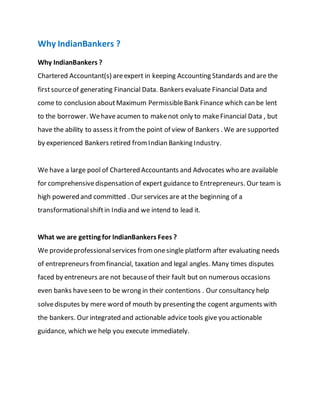This document provides information about IndianBankers, a consultancy that assists entrepreneurs with financial, taxation, and legal advice when working with banks. It offers services like compiling financial data for banks, helping with credit ratings to secure lower interest rates, and guiding clients on best banking products and processes. The consultancy aims to help entrepreneurs navigate challenges with banks through its experts who are retired bankers with qualifications like CAIIB and MBAs. It guarantees confidentiality and compliance in serving clients.


![have a team of Chartered Accountants , Advocates who come fromfields
maintaining high professionaldiscipline and ethics. So our motto is to maintain
strict confidentiality of your affairs and our aim is to make you grow.
Does IndianBankers helpinworking with Credit Rating Agencies ?
A bank loan rating conveys the credit risk that the Bank is undertaking by lending
to the borrower. Every Fund Based Limit [ External Commercial Borrowings, Term
Loans, Working Capital Loans, Buyers Credit, Cash Credit / Packing Credit,
Overdraft, Bill Purchased / Discounted ] and Non-Fund Based Limits [ Bank
Guarantee , Letter of Credit ] are Reviewed , Renewed every year and each Bank
Rates Credit of their clients, as per their own Loan Policies . Banks give
concessions in interest rates based on betterment in Credit Rating .
Moreover for Big CorporateBorrowers ReserveBank of India ( RBI ) issued
guidelines in 2007, according to which banks are mandated to be get their Credit
Rating done from Eligible Credit AssessmentInstitutions ( ECAI ) such as : CRISIL ,
ICRA , CARE , ONICRA, FITCH , SMERA , Brickwork Rating . Rating process adopted
by the above Rating Agencies involves : Pre-Rating Process , Rating Process, Post-
Rating Process.
This Rating is done on tons of parameters and according to Rating Numbers,
Banks chargetheir lending Rates over and above Bank(s) BaseRates . Our experts
are capable to take load off the clients as we are well equipped in understanding
the criteria used for Credit Rating by Lending Banks themselves or by external
Credit Rating Agencies, and thus we help our clients in bettering their Credit
Rating for making them qualified for being charged lesser InterestRates. Our](https://image.slidesharecdn.com/bd110efe-79a8-471b-b038-37fc98d7949f-160518064610/85/FAQs1_IndianBankers-3-320.jpg)

![are higher in case of Infrastructureprojects. Banks lay down prudentlending
policies in respectof exposureto segments such as Real Estate, shares, stock
brokers.
What are MSMEs ?
Businesses that are declared as MSMEs , in India, which can enjoy fruit of having
Business interest rate reduction and financial subsidy , are the enterprises that
follow the following definition [ as per Section 7 of the Micro, Small and Medium
Enterprises Development ( MSMED ) Act 2006 ] :
Company
Category
In caseof enterprises engaged
in manufacturing Investmentin
Plant and Machinery
In caseof enterprises engaged in
providing or rendering of services
Investmentin Plant and
Machinery
Medium-
sized
More than Rs5 Crores but less
than 10 Crores
More than Rs2 Crores but less
than Rs5 Crores
Small More than Rs25 Lakhs Rs5
Crores
More than Rs10 Lakhs Rs2 Crores
Micro < Rs25 Lakhs < Rs10 Lakhs
Practically speaking Micro enterprises are those wherethere are less than 10
employees, Small enterprises are thosewhere there are less than 50 employees,
Medium enterprises are those wherethere are less than 250 employees . It is
because of this difficulty of attracting, engaging and retaining the right talent for
such enterprises , such businesses continuously need to respond to shifting](https://image.slidesharecdn.com/bd110efe-79a8-471b-b038-37fc98d7949f-160518064610/85/FAQs1_IndianBankers-5-320.jpg)







